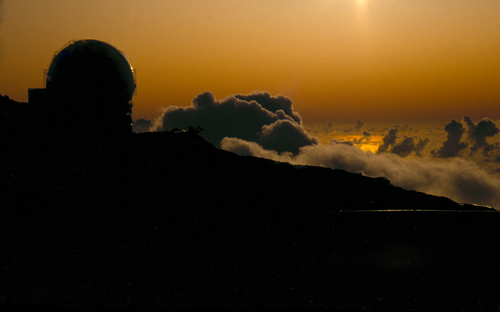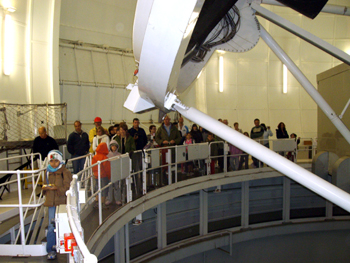
Twinkling stars are pretty, but astronomers would much rather they didn't. The twinkle is caused by movement in the air above you (the same as a mirage on very hot days) and it stops the astronomers getting a clear view. The Hubble Telescope gets such wonderfully clear images because it's out of the atmosphere altogether. But there's only one Hyubble, and it cost a fortune.
So they build ground-based telescopes wherever the airflow is really smooth, which means that the stars twinkle less. Of course, they also need to be away from city lights and clouds. The three best places in the world are La Silla in Chile, Mauna Kea in Hawaii, and the Roque de los Muchachos on La Palma. They each have observatories.
The La Palma observatory has twelve operational telescopes. From the largest aperture to the smallest, they are:
• MAGIC (17 m) a gamma-ray imaging Cherenkov telescope, which has the biggest telescope mirror in the world.
• William Herschel Telescope: (4.2 m) reflecting telescope
• Telescopio Nazionale Galileo: (3.5 m) reflecting telescope
• Nordic Optical Telescope: (2.56 m) reflecting telescope
• Isaac Newton Telescope: (2.5 m) reflecting telescope
• Liverpool Telescope: (2.0 m) robotic telescope (also reflecting)
• Mercator Telescope: (1.2 m) reflecting telescope
• Swedish Solar Telescope: (1.0 m) refracting vacuum solar telescope (the best in the world)
• Jacobus Kapteyn Telescope: (1.0 m) reflecting telescope
• Dutch Open Telescope: (0.45 m) reflecting solar telescope
• Carlsberg Meridian Telescope: (0.18 m) refracting telescope, used for measuring star positions.
• SuperWASP: (8 wide angle cameras with 0.11 m diameter lenses) surveying for extra-solar planets.
Plus GranTeCan (pictured), which is under construction and which has a huge 10.4 m mirror.
Labels: astronomy, Canaries, Canary islands, La Palma, telescopes
Bookmark with:
 Del.icio.us
Del.icio.us
 Digg
Digg
 Reddit
Reddit
 Facebook
Facebook
 Furl It
Furl It
 Newsvine
Newsvine









